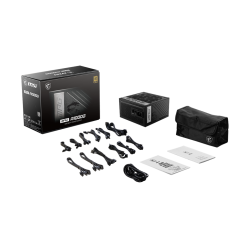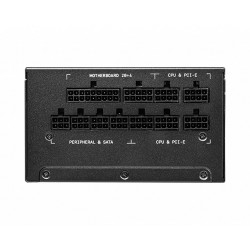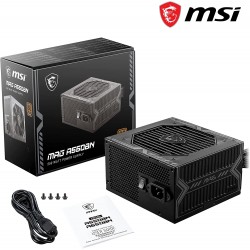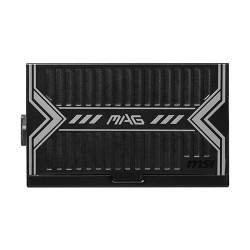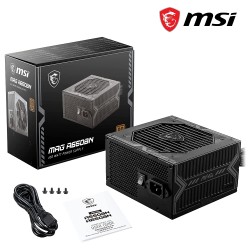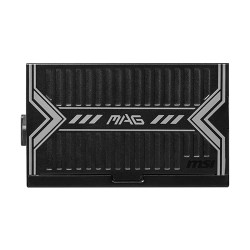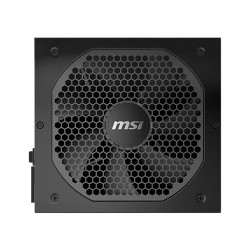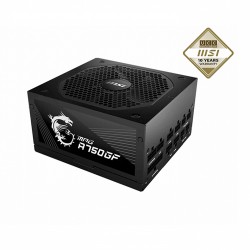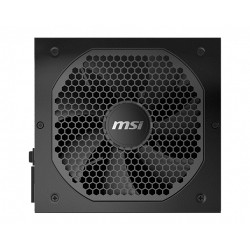19 Jan


There are many power supply options out there in the market today, each coming from different brands with different features and specifications. How should people choose a power supply that best suits their needs? Several areas should be paid attention to when purchasing a power supply unit:
Source: MSI
Power Wattage
The most basic concept of a power supply unit begins with wattage. The wattage indicated on the power supply may be different from the actual wattage. A good power supply will indicate the continuous rated power while other power supplies may only indicate the peak output power, which means they cannot provide sufficient power. The specification sticker on each power supply and the specification table marked on the packaging can help with judging the authenticity of a power supply. The following is a more in-depth explanation of continuous rated output power and peak output power.
Continuous Rated Power
This is the maximum power value within the range of the power supply that the power supply can continuously provide under any input voltage and temperature. Generally, the specification label on the back of the power supply is subject to safety regulations, so it must indicate the total rated output power that the power supply can provide, which is, the wattage that the power supply can provide.
 |
Peak Output Power
This is the peak output power value that the power supply can provide in a short time (T <10mS) before triggering the protection mechanism. Generally, the peak output power of a power supply is designed to be 1.3 times the rated power, and most power labels and specifications do not indicate the peak output power. For an 850W power supply, its instantaneous maximum output power is about 1105W (850W x 1.3 = 1105W).
For some power supplies, you will find that the total rated output power indicated on the specification label is not the same as the wattage on the product name or description. So when buying a power supply, make sure to look at the indicated total rated output power to get the right amount of wattage.
Safety Protection
Another key indicator in choosing a power supply is to look at the protection functions the power supply has to ensure that the power supply will be protected during anomalies. The common protections you'll find are OVP/OCP/OPP/OTP/SCP. A brief description can be seen is below:
OVP (Over Voltage Protection)
When the power supply is acting out, the output voltage will rise abnormally. If the voltage exceeds the voltage defined by the specification, the power supply output voltage will be cut off in time. The power supply can be restarted after the abnormality is eliminated. Therefore preventing damage to the components or the motherboard.
Definition provided by Intel's Design Guide:
 |
OCP (Over Current Protection)
When the current provided by each rail of voltage exceeds the maximum output current tolerated by the power supply, the power supply will be cut off in time for protection. After the abnormality is eliminated, the power supply can be restarted.
OPP (Over Power Protection)
If the power consumption of the system exceeds the rated power of the power supply, and the power supply will be cut off in time for protection.
OTP (Over Temperature Protection)
When the internal temperature of the power supply exceeds the design tolerance (due to poor heat dissipation or abnormal fan), the power supply will be cut off in time for protection. When the internal temperature is back to normal, it can be restarted.
SCP (Short Circuit Protection)
When the output circuits are short-circuited, the power supply will be cut off in time for protection. After the abnormality is eliminated, the power supply can be restarted.
Power Supply Rail Design and Wattage Requirements
The rail design of the power supply is separated into single-rail and multi-rail. Each design has its advantages and applications. The difference between multi-rail and single-rail designs is that a power supply has several +12V power outlets. +12V is the core system power source, so the current required is relatively large. CPU, GPU, and MB are all provided by +12V current. Generally, whether the power supply is single-rail or multi-rail can be judged from the specification table.
Single-Rail Design
As the name implies, there is only one +12V channel, and all current will be provided to the system components through this channel. The advantage of a single-rail is that all the available current is concentrated in the same circuit under the total power supply, so the amperage of a single circuit that can be supplied is relatively large. Only one +12V is displayed on the specification sheet and it indicates the maximum amperage and wattage that can be used.
 |
Multi-Rail Design
The multi-rail design splits +12V into multiple channels. This limits the amperage of each channel and installs an OCP protection device on each channel to ensure that each channel will not be damaged due to excessive current load, which improves user safety. The specification sheet will be split into multiple rails of +12V and indicate the maximum amperage and wattage that can be used for each. However, no matter how many channels there are, the total wattage remains the same.
 |
Different circuit designs and protection mechanism settings will affect the maximum wattage that the power supply can withstand, corresponding to the peak output power. Generally, power supplies' peak power will be designed to be 1.3 times the rated power before the protection mechanism is activated. After the protection mechanism is activated, it depends on the OCP and OPP protection values set by each company. OCP is usually more influential in the multi-rail design and for single-rail OCP settings are almost the same as OPP settings.
Take MPG A850GF as an example. Each +12V channel is based on the highest ampere marked. The number multiplied by the OCP setting value represents the highest instantaneous power it can withstand, usually depending on the CPU and VGA settings. Different installation methods will also determine how much wattage the VGA and CPU can get. It is recommended that VGA be plugged into VGA1 and VGA2. Do not install on the same channel so that VGA can get a larger current supply under the safety protection mechanism.
OCP Converted Power Calculation Value
+12VCPU: 25A x 1.3 x 12V = 390W
+12VVGA1: 40A x 1.3 x 12V = 624W
+12VVGA2: 40A x 1.3 x 12V = 624W
OPP is set at an average value of 1.3 times the rated power, so the entire power supply can reach 1105W (850W x 1.3 = 1105W) instantly.
We used the game benchmark to simulate the power consumption required by players when playing games on 4K and FHD resolution settings. We also used the AIDA64 + 3Dmark D12X test to check how much wattage is required to meet the demand under the most wearing conditions.
The following is the list of components used in the test samples:
Test Sample 1
- MB: MEG Z490 ACE
- CPU: Intel i9-10900K (Turbo Boost on)
- VGA: RTX 3090 Gaming X Trio
- PSU: MPG A850GF
Test Sample 2
- MB: MEG X570 UNIFY
- CPU: AMD Ryzen™ 9 5950X (Game Boost on)
- VGA: RTX 3090 Gaming X Trio
- PSU: MPG A850GF
 |
 |
From the conclusion we can draw from the game simulation and stress tests, we can see the average wattage (RMS wattage) doesn’t exceed 600W, and for peak wattage (Max wattage) the wattage is all within the protection range of OPP (MPG A850GF is 850W x 1.3 = 1105W).
Modular Cable Design & Customization
There are three types of power supply cable modularity: full modular, semi-modular and non-modular. The main difference lies in whether the cables can be removed. The advantage of the full modular is that the cables can be installed according to the assembly requirements to save space and improve cable management. The cables can also be customized with different looks and colors.
 |
 |
MSI MPG series power supply power pin definition.
80 PLUS Power Efficiency Rating
The 80 PLUS is a certification for the energy efficiency conversion of a power supply. It is divided into 6 tiers. The higher the level means a higher energy efficiency conversion rate and more power saving. Typically, to achieve a good conversion, the power supply needs to use better materials. The following are the conversion efficiency requirements of the 80 Plus energy consumption specification at different levels.
 |
Power Supply Unit Recommendation for Graphics Cards and CPUs
The chart below is how we recommend power supply units for NVIDIA graphics cards when paired with Intel/AMD CPUs. The upcoming AMD card's power consumption numbers will be provided later on.
| NVIDIA RTX 40 Series | ||||
| Intel i5 AMD R5 | Intel i7 AMD R7 | Intel i9 AMD R9 | Intel HEDT AMD ThreadRipper | |
| NVIDIA RTX 4090 | 850W | 1000W | 1000W | 1300W |
| NVIDIA RTX 4080 | 750W | 850W | 850W | 1000W |
| NVIDIA RTX 4070 Ti | 750W | 850W | 850W | 1000W |
NVIDIA RTX 30 Series | ||||
| Intel i5 AMD R5 | Intel i7 AMD R7 | Intel i9 AMD R9 | Intel HEDT AMD ThreadRipper | |
| NVIDIA RTX 3090 Ti | 850W | 1000W | 1000W | 1300W |
| NVIDIA RTX 3090 | 750W | 850W | 850W | 1000W |
| NVIDIA RTX 3080 Ti | 750W | 850W | 850W | 1000W |
| NVIDIA RTX 3080 | 750W | 850W | 850W | 1000W |
| NVIDIA RTX 3070 Ti | 650W | 750W | 750W | 850W |
| NVIDIA RTX 3070 | 650W | 650W | 750W | 850W |
| NVIDIA RTX 3060 Ti | 550W | 650W | 750W | 750W |
| NVIDIA RTX 3060 | 550W | 550W | 650W | 750W |
| NVIDIA RTX 3050 | 550W | 550W | 550W | 650W |
For more information, please refer to MSI’s website.
MEG Ai1300P PCIE5 https://www.msi.com/Power-Supply/MEG-Ai1300P-PCIE5
MEG Ai1000P PCIE5 https://www.msi.com/Power-Supply/MEG-Ai1000P-PCIE5
MPG A1000G PCIE5 https://www.msi.com/Power-Supply/MPG-A1000G-PCIE5
MPG A850G PCIE5 https://www.msi.com/Power-Supply/MPG-A850G-PCIE5
MPG A750G PCIE5 https://www.msi.com/Power-Supply/MPG-A750G-PCIE5
MPG A1000G https://www.msi.com/Power-Supply/MPG-A1000G
MPG A850GF https://www.msi.com/Power-Supply/MPG-A850GF
MPG A750GF https://www.msi.com/Power-Supply/MPG-A750GF
MPG A650GF https://www.msi.com/Power-Supply/MPG-A650GF
MAG A650BN https://www.msi.com/Power-Supply/MAG-A650BN
MAG A550BN https://www.msi.com/Power-Supply/MAG-A550BN
Source: MSI

